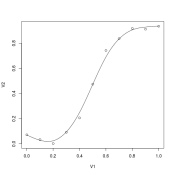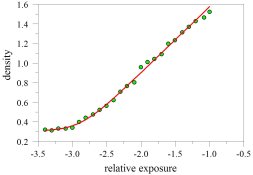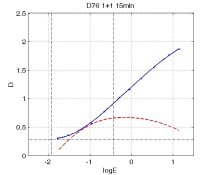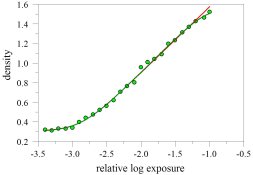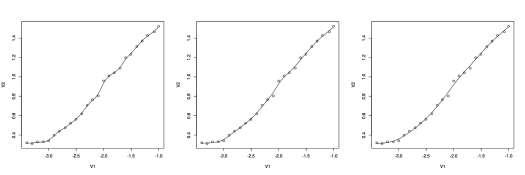alanrockwood
Member
- Joined
- Oct 11, 2006
- Messages
- 2,185
- Format
- Multi Format
I have been experimenting with fitting curves for film testing. I think I have found some equations that do a pretty good job. They are not based of well established physical theory, but I believe they are based on some qualitatively reasonable physical concepts.
I will start with a simple equation designed to fit the toe and straight line part of the curve. Instead of working in log(exposure) and absorbance (i.e. density) coordinates I will work in linear exposure and transmission coordinates. (It is possible to transform the results to new variables in log(exposure) and absorbance.)
First, I assume that at zero exposure the transmission of developed film is some amount given by Fl, where Fl is defined as 10^Fg, where Fg is base plus fog in absorbance space. This simply converts base plus fog between absorbance space and transmission space.
Then I assume that the transmission as a function of exposure decreases asymptotically toward zero. (This assumption does not allow for a shoulder in log(exposure) and absorbance coordinates, but that problem can be fixed using a more elaborate fitting equation designed to handle this issue.)
As a first guess at an equation one might try
Tr=Fl/(1+Ex)
where Tr is the transmission (i.e. fraction of light passing through the film), Fl relates to base plus fog as described earlier, and Ex is the exposure.
This equation has some useful qualitative features, i.e. in log(exposure), absorbance space it has an asymptotic value equal to base plus fog as zero exposure, followed by a toe region, and then a linear region. However, it is not flexible enough because it does not allow one to place the toe, does not allow one to specify how abrupt the toe is, and does not allow one to match the slope of the linear region.
To allow one to place the toe one can modify the equation as follows.
Tr=Fl/(1+(Ex/Et)
Where Et controls where the toe is located on the exposure curve.
One can control the how gentle the transition is in the region of the toe and the slope in the linear region by introducing two more parameters, m and n as follows.
Tr=Fl/(1+(Ex/Et)^m)^n
By taking the limit as Ex approaches infinity one can show that the slope in log(Tr), absorbance space is controlled by m*n.
One can also show that when Ex/Et is small compared to 1 (i.e. in the deepest part of the toe region) curve is basically controlled by m*(Ex/Et)^n.
I won't go into the details of the math, but I believe that by using for parameters, Fl, Et, m, and n it is possible to provide a good fit to a typical exposure curve, i.e. one can fit base plus fog, the location of the transition region between base plus fog and linear, the slope of the linear region, and the abruptness or gentleness of the transition region.
I have tried this on a limited amount of experimental data, and it seems to work pretty well.
The weakness of this equation is that it results in infinite density at infinite exposure. Instead there is a straight line that goes to infinity. It is possible to make the equation more elaborate in order to introduce a shoulder, but I would go into that right now.
With modern software one can fit the equation to produce a continuous smooth curve that gives a good representation of the experimental curve, but the bumps and jags in the experimental data have been smoothed out. (By the way, this scheme should work much better than conventional smoothing algorithms.)
Any comments?
I will start with a simple equation designed to fit the toe and straight line part of the curve. Instead of working in log(exposure) and absorbance (i.e. density) coordinates I will work in linear exposure and transmission coordinates. (It is possible to transform the results to new variables in log(exposure) and absorbance.)
First, I assume that at zero exposure the transmission of developed film is some amount given by Fl, where Fl is defined as 10^Fg, where Fg is base plus fog in absorbance space. This simply converts base plus fog between absorbance space and transmission space.
Then I assume that the transmission as a function of exposure decreases asymptotically toward zero. (This assumption does not allow for a shoulder in log(exposure) and absorbance coordinates, but that problem can be fixed using a more elaborate fitting equation designed to handle this issue.)
As a first guess at an equation one might try
Tr=Fl/(1+Ex)
where Tr is the transmission (i.e. fraction of light passing through the film), Fl relates to base plus fog as described earlier, and Ex is the exposure.
This equation has some useful qualitative features, i.e. in log(exposure), absorbance space it has an asymptotic value equal to base plus fog as zero exposure, followed by a toe region, and then a linear region. However, it is not flexible enough because it does not allow one to place the toe, does not allow one to specify how abrupt the toe is, and does not allow one to match the slope of the linear region.
To allow one to place the toe one can modify the equation as follows.
Tr=Fl/(1+(Ex/Et)
Where Et controls where the toe is located on the exposure curve.
One can control the how gentle the transition is in the region of the toe and the slope in the linear region by introducing two more parameters, m and n as follows.
Tr=Fl/(1+(Ex/Et)^m)^n
By taking the limit as Ex approaches infinity one can show that the slope in log(Tr), absorbance space is controlled by m*n.
One can also show that when Ex/Et is small compared to 1 (i.e. in the deepest part of the toe region) curve is basically controlled by m*(Ex/Et)^n.
I won't go into the details of the math, but I believe that by using for parameters, Fl, Et, m, and n it is possible to provide a good fit to a typical exposure curve, i.e. one can fit base plus fog, the location of the transition region between base plus fog and linear, the slope of the linear region, and the abruptness or gentleness of the transition region.
I have tried this on a limited amount of experimental data, and it seems to work pretty well.
The weakness of this equation is that it results in infinite density at infinite exposure. Instead there is a straight line that goes to infinity. It is possible to make the equation more elaborate in order to introduce a shoulder, but I would go into that right now.
With modern software one can fit the equation to produce a continuous smooth curve that gives a good representation of the experimental curve, but the bumps and jags in the experimental data have been smoothed out. (By the way, this scheme should work much better than conventional smoothing algorithms.)
Any comments?





